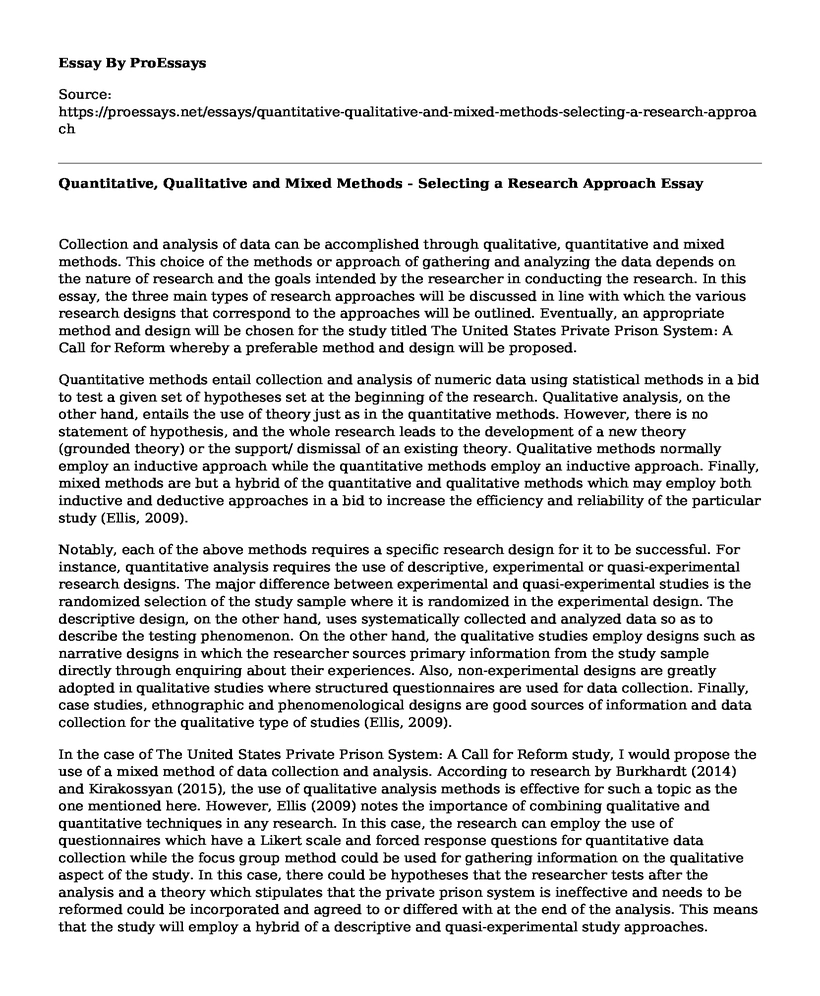Collection and analysis of data can be accomplished through qualitative, quantitative and mixed methods. This choice of the methods or approach of gathering and analyzing the data depends on the nature of research and the goals intended by the researcher in conducting the research. In this essay, the three main types of research approaches will be discussed in line with which the various research designs that correspond to the approaches will be outlined. Eventually, an appropriate method and design will be chosen for the study titled The United States Private Prison System: A Call for Reform whereby a preferable method and design will be proposed.
Quantitative methods entail collection and analysis of numeric data using statistical methods in a bid to test a given set of hypotheses set at the beginning of the research. Qualitative analysis, on the other hand, entails the use of theory just as in the quantitative methods. However, there is no statement of hypothesis, and the whole research leads to the development of a new theory (grounded theory) or the support/ dismissal of an existing theory. Qualitative methods normally employ an inductive approach while the quantitative methods employ an inductive approach. Finally, mixed methods are but a hybrid of the quantitative and qualitative methods which may employ both inductive and deductive approaches in a bid to increase the efficiency and reliability of the particular study (Ellis, 2009).
Notably, each of the above methods requires a specific research design for it to be successful. For instance, quantitative analysis requires the use of descriptive, experimental or quasi-experimental research designs. The major difference between experimental and quasi-experimental studies is the randomized selection of the study sample where it is randomized in the experimental design. The descriptive design, on the other hand, uses systematically collected and analyzed data so as to describe the testing phenomenon. On the other hand, the qualitative studies employ designs such as narrative designs in which the researcher sources primary information from the study sample directly through enquiring about their experiences. Also, non-experimental designs are greatly adopted in qualitative studies where structured questionnaires are used for data collection. Finally, case studies, ethnographic and phenomenological designs are good sources of information and data collection for the qualitative type of studies (Ellis, 2009).
In the case of The United States Private Prison System: A Call for Reform study, I would propose the use of a mixed method of data collection and analysis. According to research by Burkhardt (2014) and Kirakossyan (2015), the use of qualitative analysis methods is effective for such a topic as the one mentioned here. However, Ellis (2009) notes the importance of combining qualitative and quantitative techniques in any research. In this case, the research can employ the use of questionnaires which have a Likert scale and forced response questions for quantitative data collection while the focus group method could be used for gathering information on the qualitative aspect of the study. In this case, there could be hypotheses that the researcher tests after the analysis and a theory which stipulates that the private prison system is ineffective and needs to be reformed could be incorporated and agreed to or differed with at the end of the analysis. This means that the study will employ a hybrid of a descriptive and quasi-experimental study approaches.
In conclusion, the study The United States Private Prison System: A Call for Reform could be more reliable if it combines the qualitative views and sentiments of those engaged with the private prison system. At the same time, considering the qualitative data of the progress and effectiveness of the private prison system as documented in the prisons archives and other studies related to this could have made it more reliable.
References
Burkhardt, B. (2014). Private Prisons in Public Discourse: Measuring Moral Legitimacy. Sociological Focus, 47(4), 279-298. http://dx.doi.org/10.1080/00380237.2014.940264
Ellis, L. H. R. D. W. (2009). Research Methods in Criminal Justice and Criminology. Blue Ridge Summit: Rowman & Littlefield Publishers. Retrieved from http://ebookcentral.proquest.com/lib/apus/detail.action?docID=500811 Created from apus on 2017-03-21
Kirakosyan, V. (2015). Profits Before People: The Effect of Prison Privatization on U.S. Incarceration Rates and Recidivism (Senior Honors Thesis). University of California, San Diego.
Cite this page
Quantitative, Qualitative and Mixed Methods - Selecting a Research Approach. (2021, Apr 21). Retrieved from https://proessays.net/essays/quantitative-qualitative-and-mixed-methods-selecting-a-research-approach
If you are the original author of this essay and no longer wish to have it published on the ProEssays website, please click below to request its removal:
- Changing Criminal Behavior Essay Example
- Limitations of Utilizing Psychological Theories in Criminal Prosecution - Paper Example
- Rights of an Engineer Essay Example
- Essay Example on Protecting the US Homeland: The 2002 Emergency Preparedness Act
- Essay on Protecting Patient Confidentiality: HIPAA & Beyond
- Essay Example on NSO Group Accused of Spying: Security Loophole in WhatsApp
- Paper Sample on Capstone Corp Dismissal: Paula's Right to Free Speech







